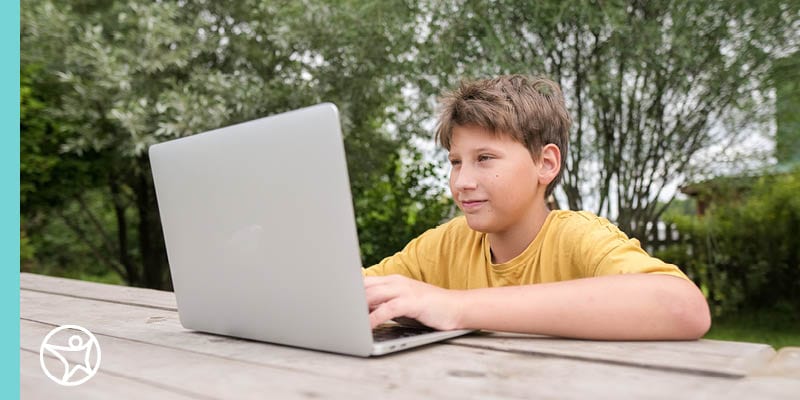How to Create an Organized At-home Classroom in a Small Space
byKristina Cappetta
6 min to read
When you look around your home, you may think that creating a dedicated classroom area for online schooling is impossible. But no matter how little space you have, the transition to online learning can be easier when you know how to organize and have the right tools.
We’ve compiled some tips for organizing your classroom at home and setting up a small classroom without needing all the bells and whistles to provide the best learning environment for your student—even if it is from the kitchen table! We’re also going to share some items you’ll need for organizing your classroom as well as some do’s and don’ts for organizing your classroom at home.
Top Tips for Setting Up a Small Space Classroom at Home
Setting up a small classroom inside your house doesn’t have to be a major project when you follow these tips:
Does a classroom really have to be a “room”?
No, it doesn’t! Be creative about your student’s learning space. As long as there is a dedicated area, you don’t have to have an entire room. Check out that space under a lofted bunk. You can even buy a room divider to section off a corner in your home while your child is actively learning. When you start to think out of the box, you’ll be surprised at what you come up with.
Tuck away supplies that aren’t being used.
When you’re organizing your classroom at home, a hall closet can be a great space for school supply storage. By installing inexpensive wire shelving from top to bottom in the closet, you’ll be able to neatly organize school supplies and put away learning materials your student doesn’t use every day.
A cabinet in your kitchen that isn’t full or used often can easily store those extra school supplies. For more organization, pick up plastic storage bins, fill them neatly with supplies, label them, and store them in the cabinet.
Use the backs of doors to create educational tools.
Attach a dry-erase board to the top half of a door and paint the bottom with magnetic paint to turn it into an instructional area and a place to display great work. You could also use the space to hang maps, the alphabet, or other educational materials.
When you want to know how to organize schoolwork at home, hang a 24-pocket, over-the-door shoe organizer and store supplies in each pocket. If possible, try to find a clear version, which makes it easier for you and your student to see what’s in each pocket.
Add storage on top of surfaces.
If you’re trying to find new storage spaces, look up! Add storage on top of under-utilized surfaces. This eliminates the need for another piece of furniture and makes the area look neater.
Use rolling carts.
When storage is at a minimum, invest in a rolling cart. You can put all the supplies you need for the day and any supplementary teaching tools in the cart and just roll it out when it’s time for class.
Convert a wall into a chalkboard wall.
If you have an empty wall near your learning space, coat it with chalkboard paint to create a chalkboard wall. You can teach lessons, keep track of assignments, and let kids be creative by drawing on it. Plus, you save the hassle of looking for space for a chalkboard.
Top 3 Items You Need When Organizing Your Classroom at Home
When it comes to organizing your classroom at home, you may need fewer items than you think. Here’s a quick look at the top three items you’ll need:
Organized student desk
Your student needs to have an organized student desk area where they can work. But rather than trying to make a full desk work, you can think out of the box for this one. Try building your own desk to fit any space.
Two filing cabinets with a strong, flat surface across the top create a simple desk solution. The filing cabinets provide organized storage for papers, books, and other school supplies. Encourage your student to decorate the space with educational posters or inspirational quotes.
School supplies
Although your student is participating in online classes, you’ll still want to have basic school supplies like paper, pencils, and crayons.
Laptop or computer
If you’re tight on space, a laptop will do just fine. If your student needs to print things out, consider a wireless printer that you can put anywhere in your home.
Want more specifics on what you need to set up a learning space? We’ve created a shopping list that outlines basic school supplies you’ll need to set up a small house classroom.
4 Do’s and Don’ts of Setting Up a Small Classroom in Your Home
Here are some quick do’s and don’ts to help you make the most of your home classroom:
Don’t be married to the idea of using just one area.
When you’re organizing your classroom at home, don’t be attached to the idea of having just one learning area. Consider spreading out to other small spots in a few rooms. One could have a reading nook, the other could be a technology table with a laptop... By using your imagination, you can maximize the space you do have while providing your student with a change of scenery during their learning time.
Don’t forget about natural lighting.
If you’re trying to avoid placing lamps in your space, check out how much natural lighting you have in the room. This can eliminate the need for multiple lamps, saving you space.
Do consider a wall-mount folding desk.
Tight spaces call for a wall-mount folding desk, otherwise known as a Murphy desk. This is a type of desk that folds down from the wall, so it doesn’t take up any floor space when it’s not in use.
Do assemble a morning basket.
Finally, be sure to assemble a basket each morning of any books or activities you’re planning to use to supplement your online work. This not only helps when it comes to organizing your classroom but also lets your student know what’s in store for the day ahead.
When you’re looking at how to organize your virtual classroom at home, having the proper tools as well as thinking out of the box can help you make the most of the space you do have without spending a cent. Your house classroom can become the perfect setting for your student to excel!



